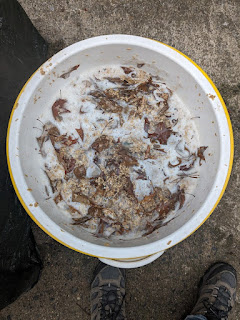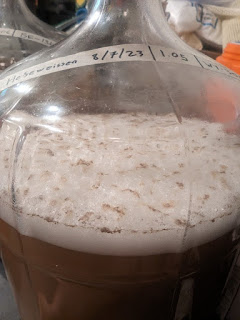Fruitfall / Winter Warmer
It’s been a while since we brewed last, so the ideas have been piling up. It’s probably easy to tell from this recipe why we’re so excited about this brew. We managed to get enough wort to split this up into three decent-sized batches, so we’re going to get to try out a few interesting ideas that we’ve been kicking around.
The base wort here is interesting all by itself. We spent the evening before brewing chopping up about ten pounds of fall fruit - two kinds of apples, two kinds of pears, and a small carton of figs - and caramelizing them over low heat for several hours. As the sugars in the fruit are cooked, they slowly undergo Maillard reactions that turn them into longer, more complex sugars, some of which can’t easily be digested by yeast. The result should be a rich, caramelly fruit flavor that lingers in the finished beer.
We also gathered, washed, and dried a bucket full of the oak leaves that are falling in our backyard. One of our most recent brews, a pumpkin beer recipe courtesy of The Homebrewer’s Almanac, involved a few quarts of sassafras leaves in the boil, which we thought turned out nicely. This recipe is also based on one from The Homebrewer’s Almanac, but this time we’re treating it more as guidelines than actual rules. We added about a pound of dried oak leaves to the mash, rather than the boil, which we’re hoping will give us a light oaky flavor to balance against our caramelized fruit.The mash went ahead without a hitch. Unlike the sassafras leaves, which turned to mush in the boil and caused some issues with draining and filtering, the oak leaves retained their shapes and probably helped with drainage. We’re running into the limitations of a 10 gallon mash tun, but we managed to get about 6.5 gallons in on top of a very full grain bed. The temperature came in at 160F after mixing, which is a little bit high, but we decided not to stress it and left the lid off. After an hour, it was down to about 147F, and we figured that’s close enough. This temperature schedule probably favored alpha-amylase, which cuts starch molecules up at random, rather than beta-amylase, which cuts them into neat glucose molecules, so it’s possible that the beer will finish a bit high.
The boil was similarly straightforward (although we did have a bit of boil over from boiling with such a full kettle!). We ended up with a post-mash gravity of 1.07, which was a bit high for our taste, so we added in a few gallons of water to start at 14 gallons and 1.042. The original recipe calls for the hops to be added at 60 minutes, but suggests substituting half of the bittering charge for an ounce of hickory leaves. We used substantially more oak leaves, following guidelines from a different recipe (their delicious looking “Single Tree: Oak”) but guessed that extracting them in the mash rather than the boil would reduce their bittering impact. As a compromise, we kept the full ounce of Chinook hops, but moved it to 15 minutes.
This is where things started to get really interesting. We split up the post boil volume of about 11.5 gallons into three fermentors - two glass carboys and a corny keg fitted with a floating dip tube. We want to do more fermenting in corny kegs to reduce our cold side oxygen intake, but at the moment our brewing is outpacing our consumption and most of them are full!
The first glass carboy got about 3.5 gallons and a pitch of Mangrove Jack Liberty Bell yeast, a pretty standard American ale yeast. We’ll probably just let that one do its thing for a few weeks, keg it up and force carbonate for a crisp, fall apple ale.
The keg got about 4 gallons and a half pitch of Lallemand Voss Kveik and a warming jacket set to hold it at 90F. We don’t have a thermowell for the keg, so with the temperature probe taped to the side, I’m guessing that the liquid inside is about 10 degrees hotter. We fitted it out with a blowoff tube and the kveik is already ripping through the sugars in there. This one, we are going to try sugar priming with a bit of the Japanese cedar mugolio that we made over the summer using green pine cones from our backyard. It has an amazing cedar aroma to it and I’m really interested to see how much of that finds its way into the finished beer.
Finally, we have our weirdo of the bunch. The second carboy also got 4 gallons and an initial pitch of White Labs Metschnikowia Reukaufii. M. Reukaufii isn’t a brewer’s yeast at all - it’s a yeast found in nectar that scientists suspect of playing a role in creating more aromatic compounds to attract pollinators. Fascinating stuff. It isn’t widely used, but brewers have been experimenting with it as a co-pitch, especially for big hazy IPAs. This is a bit of a weird use for it, but a) it can only ferment fairly simple sugars so we thought a beer with a lot of those from apples might be a good home for it, and b) we needed to give the starter that is going to take this beer the rest of the way a bit more time.
That starter was built up from some dregs we harvested from the bottom of a 10 gallon barrel that’s been fermenting in our basement. You can never tell for certain what’s in a used barrel, but we’ve pitched BE-256, SafAle’s Belgian Abbey strain, and Brett Bruxelles into it, so it’s a safe bet that those are still there. We’ll let the M. Reukaufii have 24 hours to get a good foothold and then drop the temperature down to 60F and let the BE-256 take us through primary. When that’s done, we’re going to add a pound of the mugolio (boiled in a bit of water to sanitize and make a less viscous syrup) and start letting the temperature slowly creep up to 72F over a week or so. When that’s done, we’ll drop it back down to 57F and let the brett work for about a month before we package it and do our best to wait until Christmas to try what we’re hoping will be a very complex Belgian Tripel.
- 6.5 Gallons Step Mash
- 3 Gallons Batch Sparge
- 3 Gallon Batch Sparge
- 10 bs Vienna Malt
- 4 lbs White Wheat Malt
- 3 lbs Munich Malt
- 1 lb Cherry Smoked Malt 20L
- 1 lb Flaked Oats
- 1 lb Flaked Rye
- 10 lbs Caramelized Apples, Pears, and Figs (Added to boil at 10 minutes)
- (Fermentor C) 1 lb Japanese Cedar Mugolio (Added to fermentor after high krausen)
- 1 oz Chinook @ 15 minutes
- 1 lb Dry Oak Leaves in Mash
- 4g Gypsum*
- 4g Calcium Chloride*
- 1g Epsom Salt*
- 1 tsp Yeast Nutrient
- 1 tsp Irish Moss
- 1 lb Rice Hulls
- Fermentor A: 1 pkt Mangrove Jack Liberty Bell
- Fermentor B: 0.5 pkt Lallemand Voss Kveik
- Fermentor C: 1 pkt White Labs Metschnikowia Reukaufii
- Fermentor C: 1600 ml Active Starter of BE-256 and Brett Brux. (Harvested from barrel dregs) at 24h
- Mash for 60 minutes at 150F
- Drain and batch sparge for 20 minutes at 170F (twice)
- Boil for 90 minutes, adding hops, nutrient, and irish moss according to schedule
- Cool, transfer to fermenter, oxidate and add yeast
- Ferment for 14 days until primary fermentation finishes
- Cold crash for 3 days
- Package and force carbonate
- Bring temperature up to between 90F and 100F to accommodate Voss Kveik
- Ferment for 3 days until primary fermentation finishes
- Soft crash to 60F for 3 days
- Closed transfer to a purged keg and prime with mugolio in boiled water
- 24 hours after M. Reukaufii pitch, cool to 60F and pitch active starter
- Hold at 60 until primary fermentation is finished and add mugolio
- Allow to rise in temperature to 72F over 10 days
- Cool to 57F and hold for 4 weeks
- Prime with caramelized sugar, package, and cellar as long as we can stand to



Comments
Post a Comment